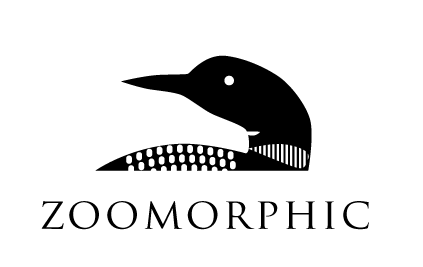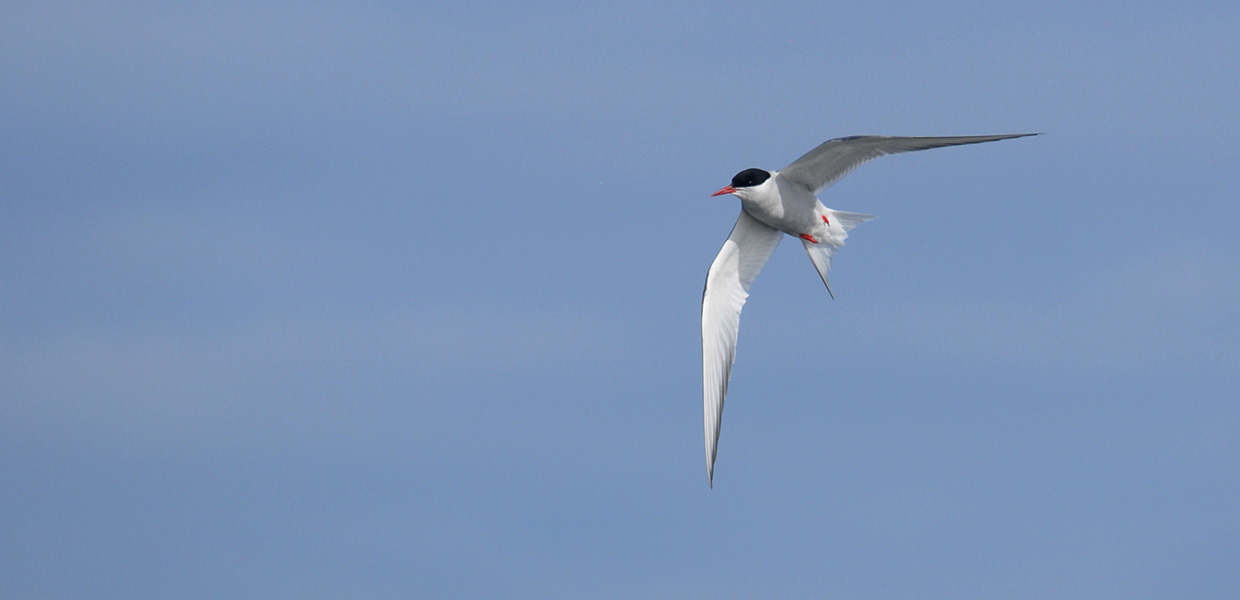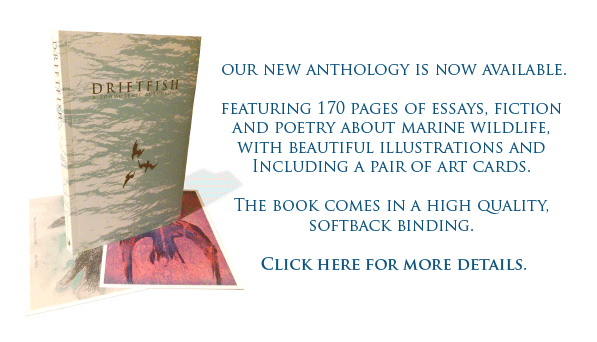by Stephen Rutt
It had died in the past hour. Severed, crimson-fresh, and glassy eyed. Soft to touch — pre rigor mortis. I’d pulled it out of the long grass under the wind turbine. An arctic tern with one wing, one head, one severed chest. Its heart, as thick as my thumb but half as long, glistened, still damp with blood. With that small organ pumping life around its body, it flies from here to the southern oceans and back to this small island — 30,000 miles a year. I saw the length of the world in its heart, a map in its gristle, flyways in its sinews.
I’d spent three months on the island before the arctic terns appeared. The island was North Ronaldsay, a four-mile-long fragment of rock, an aberration in the sea on the northern edge of the Orkney archipelago. Twenty-seven miles beyond lies Fair Isle, visible on clear days. Occasionally Foula, fifty miles due north, could be seen in the absolute clarity of early morning, before the air filled with salt haze. It appeared like a child-drawn volcano, an acute triangle of rock in the Atlantic. I’d become used to this scale. By the distances of modern life they weren’t too far away. On the scale of an island’s horizon, massive. Fair Isle and Foula belong to a different archipelago, one that is almost impossible to get to from here. They have a different dialect and a different identity. Over there they call a tern a ‘tirrick’. On North Ronaldsay we use ‘pickieterno’.
The terns appeared out of the grey, ahead of a squall, one morning in May. Sterna paradisea: tern of paradise. Like an old friend reacquainted from last year, it was both joyful and jarring. I always forget over the winter quite how they look. How small, thin and light they are. The elastic elegance of their wing beats, as if they fly through a different substance, lighter, more buoyant than air. They bear a superficial resemblance to seagulls. They have a glossy black cap. Vivid red feet and a bill as bright. The bill is stout, though up close more delicate looking, with a gentle downward curve. Their legs are tiny, and when they are perched they resemble pale flakes of rock. Like an overcast sky, the body and wings are soft grey and white. Against the light the wings are translucent white, though smudged with a smoky grey edge. The white and grey tail is as long as a swallow’s streamer and responsible for the colloquial name, sea swallow. As with all close relatives they are and they aren’t like seagulls: familiar in features and utterly different in spirit.
The terns have come here to breed; I have come here to help count them. North Ronaldsay bird observatory thrives on volunteer staff that come from all over Britain, united by a love of birds. We are not ornithologists but variously builders from Cornwall, Somerset fishmongers, gap year students, future doctors and exiles from London without a science degree between us. We count and tag the birds that migrate through or breed on the island as part of the observatory’s work, the twenty-ninth consecutive year this has happened. It doesn’t take us long to get into the swing of work and life in such a remote part of Britain. The terns don’t take long either. Within a week the old colonies on the preferred rocky outcrops around the coast are alive again. That’s where I needed to go for monitoring.
A sharp pinprick. The splatter of shit on the back of my coat. I was being driven off. Terns overhead, queuing in the air above me, taking turns. They cry — a noise like they’re being ripped in two but with almost mechanical regularity. I had seen this before on TV. A polar bear stumbling over rocks in the tundra, arctic terns darting down, showering it with blows until they drew blood. The bear moves away; the tern is mightier. Another tern made a pass at my ear; I spun around on a seawater-slicked rock and ended up sitting in a rock pool.
Life in a tern colony is not calm. They are loud and quick, and anger pulses through them – though anger is perhaps not the word. It is vigilance and belligerence, a full-hearted defence against intruders. Colonies depend on joint defence. Individually they are smaller and lighter than gulls, skuas and sheep, but together they can drive almost anything off. The bigger the colony, the more success they’ll have.
Success seems a long way off. A tern’s definition of summer is May to August, but this far north the increasingly unpredictable climate is jeopardising that season. May was cold and grey. June was a washout. The grass didn’t grow, the cows were on silage until July. The fish came, then went, then came again. The water levels rose and rose. The first broods were destroyed, a literal washout, or for those further away from the water’s edge, the grass that didn’t grow around the nests presented them as an egg platter, or a small chick snack fit for the maw of a marauding great skua. I saw what I thought was teamwork. A pair of great skuas, one flying fast at the edge of the colony. White-tipped wings flashing in bright sunlight. It flew low and hard at the edge and the terns’ belligerent instincts kicked in. The colony rose up like a wave and chased it off. The second skua drifted over an unprotected feast.
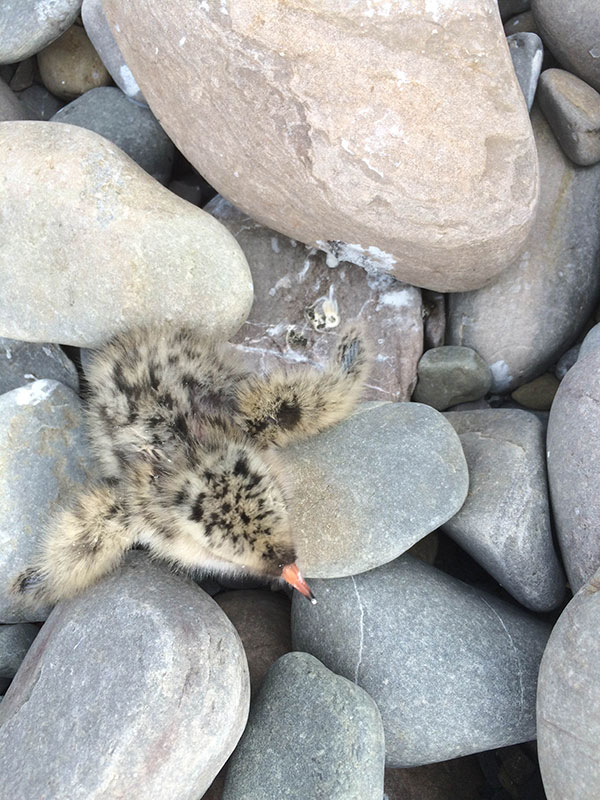
I have some sympathy for the devils. They nest on the west coast in a boggy field near the airstrip. There are no raptors on the island and the skuas fulfill that niche, picking off the plethora. They move with brute charisma, an angry swagger. If you walk too close to them they will defend their territory from you like the terns will. But they don’t feel like a pinprick. Skuas have a five foot wingspan, a bill like a machete and clawed-feet dangling as they fly straight for your head. You duck and get out of the field quickly. I have seen skuas give gannets a good head-start, then chase them down and upend them to steal their fish. There are more gannets still — one misty morning 5,000 streamed past the observatory like salmon running up an Alaskan river. There are good numbers of seabirds remaining currently, but they won’t last forever at this rate. Arctic terns are amber listed. Declines are concerning. And when they’re gone? The world loses a global species — a tie that binds the north and south, polar bear and penguin.
I’m reminded of Tennyson’s struggle to understand how nature changed around him. In the 1850s, while grief-struck, he wrote of nature: ‘So careful of the type she seems, / So careless of the single life;’ (In Memoriam, LV, L5-8). We have swung almost completely around from Tennyson’s concerns. We’re now so concerned with the single life that we forget to be careful of the type. A single dead tern under a turbine is upsetting. Global warming driving the species ever further north and south is even worse. At 59 degrees north, Orkney is at the southern end of their breeding range, a range that extends as far north as Cape Morris Jessup, the northernmost tip of mainland Greenland. They spend the winter on Antarctic pack ice. For the great travellers, there’s not much more room for them to go.
The solstice came in a thick haar — the longest day of daylight and you couldn’t see a thing. July: a blessing in 30 days where I didn’t need to wear my winter coat once. By the end of the month, the first dispersal of the year. Adults and young, successful and unsuccessful breeders, turned up on the rocks at the top of the island. Counting terns is deceptive. A manageable flock on the rocks triples in size when a skua drifts past, or a walker kicks a stone, or a sheep ventures too close. It becomes chaos, like counting snowflakes in a blizzard. It is our job as monitors to decipher the chaos — sort order out of panic. It is also, in a way, like panning for gold, such as when a black tern from Eastern Europe was found. Though not irregular in England, they’re eye-wateringly unusual this far north and west. The arctic tern flock reached 4,000 terns, or 80 birds to every islander. Those that have bred remain communal and retain aggression. Another opportunity for breeding began.
When the day’s monitoring is done, I read from a book called Birds of the Western Palearctic (BWP). It is the ornithologist’s bible — all the scientific studies on every European species summarised and condensed. It stretches to nine volumes. It is monolithic, and I feel like a heretic reading it. A faker, sidetracked by facts from Lake Myvatn in Iceland, where one arctic tern was recorded making 4.6 dives per minute with a success rate of 69.2%. I separate what I actually want to know out from the dense scientific prose. The eggs weigh on average 19 grams. 4cm by 3cm. Both parents look after the young and the bond lasts into the southward migration, but then dissolves. Apparently the parents won’t spend the winter together.
From the northernmost headland the news is not positive. Here the terns nest on a broad sweep of rock down from a headland to the sea, finding crevices amongst the rocks bunched and crumpled like discarded paper. There is no aerial frenzy, no bombardment. From a count of 150 pairs a few weeks ago, we only find three fledged young and many abandoned eggs, as cold as wet rock to touch. It is mystifying — this colony was a third bigger than the one next to it and should be better defended. It is not until we leave that we stumble across the reason why. Stashed in a hollow by the drystone dyke, half-hidden by the long grass we find a few loose tern feathers. Then a wing, a tail, legs. Half a chick, feather shafts half-grown from its downy wings. The hallmarks of cat predation. A colony without life is a haunting place. Instead of the screeching of adults, all you can hear are waves gently rolling into the shore. The conspicuousness of absence. The wrongness of it is unbearable. It feels like a disaster.
Back at the observatory I carry on my reading. BWP tells me that the terns are monogamous but ‘divorce’ happens, more frequently amongst younger birds. For the birds that lose a partner, they skip a breeding season. Then, in future years, they will return late to the colony, pair up later, breed later. I don’t know how ornithology knows this, but it feels important that someone somewhere does.
The tern blizzard has worked though. By the lighthouse we count 95 terns sat flush on the rocks, immobile and impervious to the thousands more that bustle around them. On a fine day a week or so later we entered the colony. Showered in excrement from the bird blizzard. Our heads hang, eyes scouring the ground and our footfall. Nobody wants to be the one to stand on an egg, or worse, a chick, and nobody does. It’s a dangerous time. We choose the fine days so that eggs don’t get cold or wet while the adults are up in the air. We move quickly to minimise disturbance.
On the rocks we find chicks. I find one chick hiding with its head tucked into a crevice in the rock. It is downy soft, stone brown, speckled darker. They can vanish from above, but on eye-level they look ludicrous, with adult-thick orange legs and a stubby carrot of a beak. Born two days ago, I reckon, though I can’t tell for certain. I turn it on to its back, my fingers either side cradling it. I pull out a ring and gently plier it shut, checking to make sure it fits as a perfect circle around its leg. I place it down, back where I found it, to resume its life on the hard rocks.
The ring has a unique code on it and back at the observatory it will be put into the national database. When the bird next gets trapped, the ring code will be read and logged on the database. It’s a simple method but it’s how we know that arctic terns will live for a quarter of a century. It’s how we know that one tern, ringed as a chick in Northumberland was found in Australia three months later.
I walk towards another chick I can see, looking like a stone shuffling over stones. This one is older — it has feathers instead of down, an adult-sized bill and wings that aren’t fluffy stumps. I reach down. It jumps up. Flaps its wings and takes off. First flight. Its wings are not quite fully grown, its feathers not quite the sharp-tipped tools that will take it to Antarctica. They are stumpy and half-formed, but good enough. It flaps deep wing beats and flies off down the other end of the rocks, gracefully dropping down. I guess some things just come naturally.
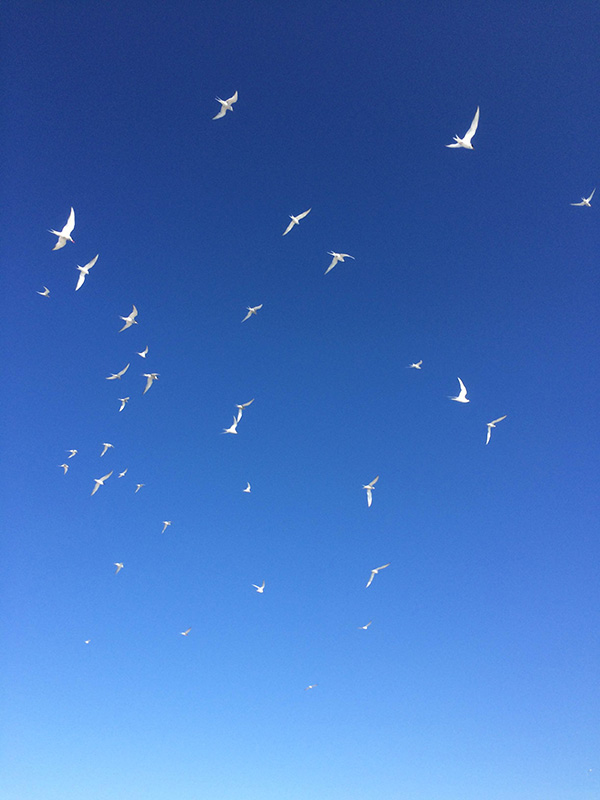
The season is out of kilter. Colonies, in an ideal world, all lay eggs and raise chicks in sync with each other. As we move through we find freshly laid eggs and recently fledged young, alongside full grown young from other colonies on other islands. I notice one egg tremble, cracks spreading throughout its shell. An egg tooth — the hard knob on the tip of its bill — breaks through, as the impulse to life drives the chick inside to break the warm wall of its embryonic state and change its world forever. It’s a complicated experience. I don’t hang around to watch it happen, despite a compulsion, the nagging sense that it will be the most extraordinary, privileged event to witness. By the same token it feels like an intrusion, a transgression of some necessary boundary. It doesn’t feel right. I am merely happy enough that there are tern chicks still hatching. It means the world to me.
From the 95 pairs we counted 59 fledged young from that colony. On paper, not the most productive part of the island, an offshoot of two pairs around the corner from that colony managed to raise all their chicks. The statistical outlier. From a total of 579 paired terns, 95 chicks were fledged. A 0.16 productivity rate looks terrible, but in reality it is a relief, each fledged chick a victory in defiance of a most unpredictable summer. As the season ends in August the 4,000 strong flock dwindles to several hundred, then a mere handful of birds. Shetland, Norwegian, Icelandic young pass through. Possibly even Greenlandic young — maybe the birds from 84 degrees north at Cape Morris Jessup — might pass through on the back of a gale.
Autumn. Absence again. Silence. Wind and rain. The occasional tern still hurries past, south-bound, but suddenly they seem out of place. They are no longer starkly white against a blue sky, but grey and flimsy, too light for the weather we experience. They should be halfway south by now — a month and a half after fledging — the birds breeding north of the arctic circle experiencing night properly for the first time around the equator. In another month or so, as we slip into winter, they’ll be back in the season they chase from one end of the earth to the other, at home, in perpetual daylight on the pack ice of the Antarctic summer.
Header image by Stephen Rutt
Stephen Rutt is a naturalist, writer and photographer from East Anglia. He has recently completed the MA in Wild Writing from the University of Essex and his work has appeared in Earthlines, The Harrier and on the Wild Easters blog. He tweets a lot @steverutt
